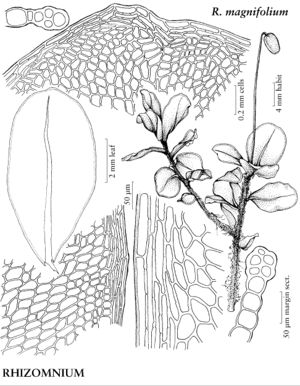Rhizomnium magnifolium
Ann. Bot. Fenn. 10: 14. 1973.
Plants (2–)3–6(–10) cm. Stems reddish brown to black when old; micronemata present, often absent on young stems. Leaves green to dark green, contorted when dry, obovate or broadly elliptic, 4–9(–12) mm; margins green or sometimes reddish, 1- or 2-stratose; apex rounded or retuse, sometimes emarginate, rarely weakly apiculate; costa ending well before apex, subpercurrent, or percurrent, sometimes 2-fid distally; medial laminal cells elongate, (55–)80–100(–130) µm, weakly collenchymatous, walls lightly pitted; marginal cells linear, in 2–3(–4) rows. Sexual condition dioicous. Seta 2–4 cm. Capsule oblong or cylindric, 3–4 mm; operculum conic-rostrate; exostome greenish yellow, lamellae 18+. Spores 25–35 µm.
Phenology: Capsules mature summer.
Habitat: Forested stream banks, seeps on moist soil, humus, rock
Elevation: low to moderate elevations
Distribution

Greenland, Alta., B.C., N.B., Nfld. and Labr., N.S., Ont., Que., Yukon, Alaska, Calif., Colo., Idaho, Maine, Mich., Minn., Mont., N.Y., N.C., Oreg., Pa., Wash., Wis., Wyo., Europe, Asia.
Discussion
Rhizomnium magnifolium, although usually large, can sometimes be small and has been confused with R. pseudopunctatum. Fertile plants of R. pseudopunctatum are synoicous, but sterile collections are common and often ambiguous. Rhizomnium magnifolium has larger and much less pitted laminal cells than R. pseudopunctatum, and its margins are composed mainly of linear cells and are usually 2-stratose; those of R. pseudopunctatum are composed of shorter and usually rectangular or rhomboidal cells and are always 1-stratose. The length of the costa is frequently used to separate these two species, but this character is unreliable with smaller specimens of R. magnifolium. The costa of R. magnifolium is often subpercurrent or percurrent, whereas the costa of R. pseudopunctatum is usually much shorter, and only occasionally subpercurrent and rarely percurrent. For comparison with the similar 2. R. appalachianum, see the discussion there.
Selected References
None.
